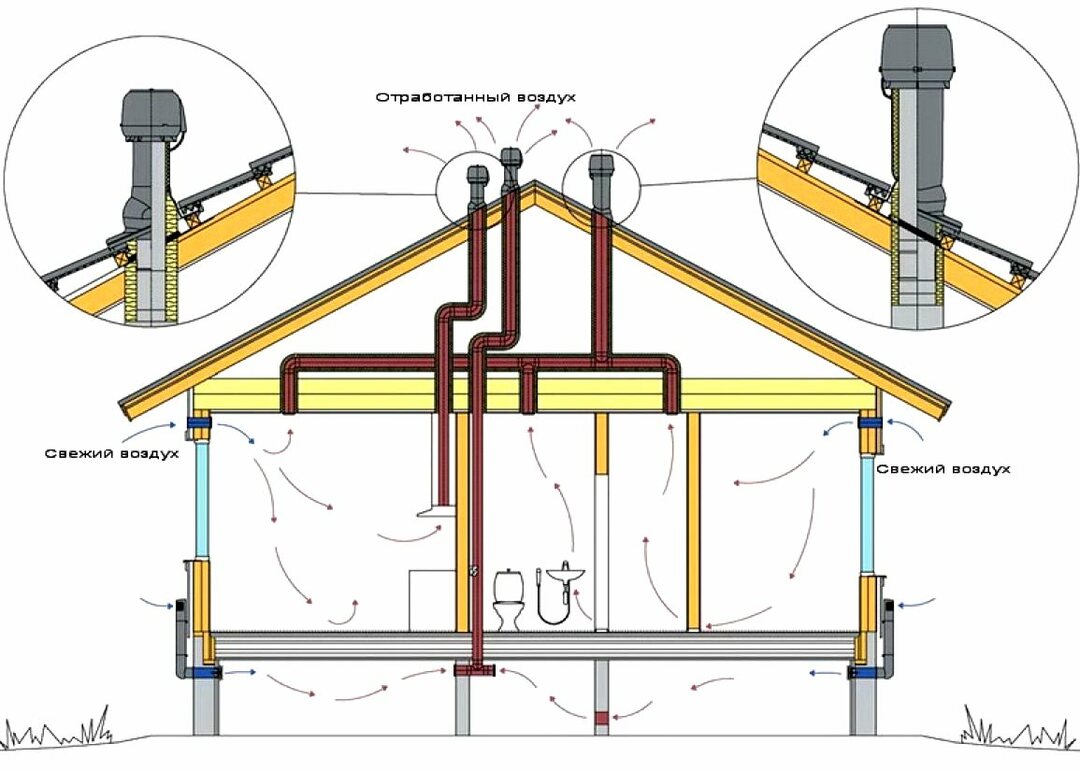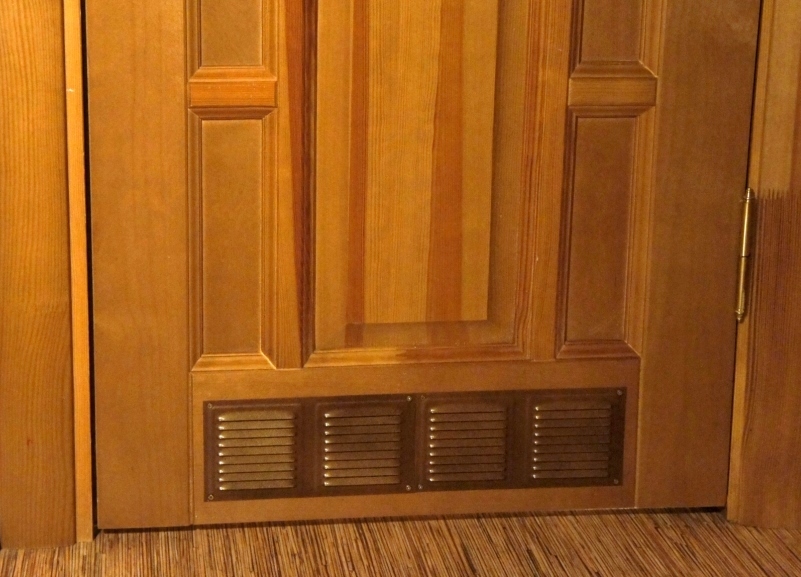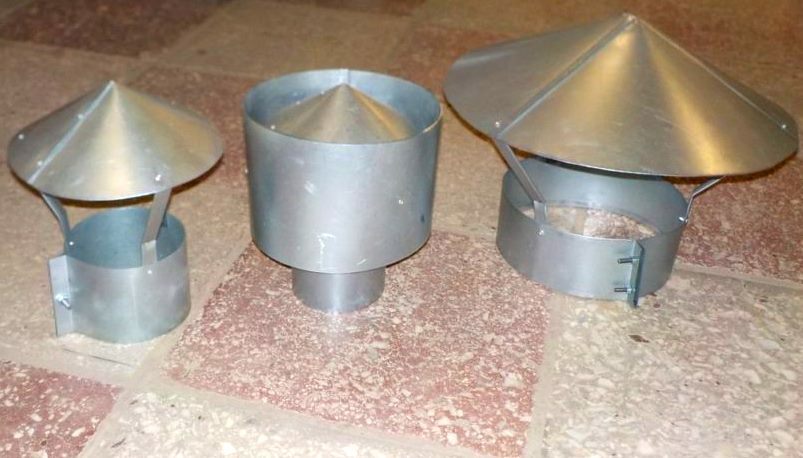One of the main conditions for a comfortable stay in a room is the quality of the air we breathe. therefore, it is very important to take care of how to make ventilation in the country, so that air circulation meets generally accepted requirements. It is obvious that too humid or dry microclimate can cause discomfort and exacerbate chronic diseases.
We do not visit the dacha all the time, but seasonally: pensioners can spend six months there, and working summer residents visit the country house only on weekends, and sometimes during their holidays. But this does not mean that living conditions should be worse than in a city apartment or cottage.
In the article, we talked about the rules for arranging ventilation in a country house and gave brief installation instructions that will be useful to those who want to improve the microclimate of a country house with their own hands.
The content of the article:
- Do you need ventilation in the country?
- Natural or forced - which is better?
-
Simple DIY solutions
- Option # 1 - improve natural circulation
- Option # 2 - mounting an axial fan
- Option # 3 - installing a supply valve
- Option # 4 - arrangement of ventilation in the basement
- Conclusions and useful video on the topic
Do you need ventilation in the country?
Skeptics will say: why waste time installing additional devices, if the dacha is a house for a temporary, short stay.
A few nights, especially in summer, can be spent with the window open, here's the ventilation.

Buying a beautiful house with a backyard, many plan to make it fully suitable for permanent housing - in this case, good ventilation is a must
In fact, comfort isn't just about fresh air. This is both normal humidity, and favorable conditions for storing fresh vegetables and preparations, with quick drying of wet clothes, and the absence of mold, along with which a musty smell settles in the house.

If you have built a new summer cottage or inherited a small old house, first tidy up the ventilation system. This is also necessary for the safety of the house itself - the materials from which it is built.
How can you tell if the air is stagnant and not circulating? Here are some obvious signs:
- condensation on window panes, flowing in rivulets onto the windowsill;
- pockets of mold on the walls, in corners or on the ceiling;
- wallpaper lagging behind the walls, cracked furniture;
- persistent "aroma" of mold and mustiness;
- cool, unpleasant atmosphere due to high humidity, even in a warm room.
Things in such a house practically do not dry out, some bugs and wood lice are constantly crawling along the walls.
There are many ways to quickly fix this unsightly situation. Often, you just need to install a device or device to help air enter / leave the room.
Some of these devices are:
Image gallery
Photo from
An inexpensive, easy-to-install fan will radically change the microclimate in the toilet, kitchen or shower. It is controlled by a switch, belongs to volatile devices, but spends a little electricity
This is the simplest device for organizing natural ventilation. If the exhaust ducts laid in the walls work well and are not clogged, then installing the valve is sufficient for active air circulation
Depending on the weather, the window can be opened slightly or wider by adjusting the sash gap. In summer, in order to protect against mosquitoes and midges, it is additionally required to install an anti-mosquito net
A simple but effective device at the head of the pipe performs important functions: it protects the channel from debris, rain and snow, and also significantly increases traction
Household exhaust axial fan
Inlet valve for wall installation
Mechanism of stepped window opening
Deflector for mounting on a ventilation duct
Even having installed one of the listed devices, you will immediately notice the difference: dampness will disappear from the house, you will not have to arrange drafts for ventilation.
Natural or forced - which is better?
According to the method of air induction, ventilation is divided into natural, which occurs without the intervention of the owners of the house, and artificial or forced, organized with the help of fans and air ducts.
The simplest example of natural ventilation is an apartment in a house with wooden windows. Although the hood is organized during construction, it obeys the laws of physics, and air is supplied through the cracks in the window and door openings, open windows and vents.

In village houses, which many use as seasonal housing, air circulation is also carried out using a brick stove with a chimney and a chimney.
But sometimes natural air exchange is not enough to create a healthy, comfortable environment for living. And then you have to use the devices listed above, embed new ones ventilation ducts.
Use as air ducts or plastic pipes or galvanized elements. They are located above suspended structures and in walls with an exit to the outside above the roof or in the wall.

To create full ventilation, whole systems of insulated sealed ducts are designed that pass through all rooms. But this option is advisable for houses of permanent residence, as it requires a more serious approach.
The best way to get proper ventilation is a combination of natural and mechanical methods to improve air circulation. From this side, a country house does not differ from an ordinary city apartment: to the half-open windows, you can add the installation of a fan in the toilet and the installation of an inexpensive hoods in the kitchen.
Simple DIY solutions
Of course, to improve the microclimate in a country house, hardly anyone will demolish the walls in order to equip full-fledged ventilation shafts. However, some useful changes can be made, and all work is easily done on our own, and devices and devices are purchased for a reasonable price.
We offer several popular options that, having tried to equip in the country, you can implement it in a more serious home. We will analyze how to make supply and exhaust ventilation in a country house without drastically redrawing the layout.
Option # 1 - improve natural circulation
Knowing that for a healthy microclimate a certain volume must enter the room and the same volume must leave it, you can simply create more favorable conditions for natural circulation.
As an example, let's take a small traditional wooden country house with a gable roof, stove and wooden windows.

Air exchange is carried out through all kinds of openings - cracks in the windows, gaps under the entrance doors, vents made in the upper part of the walls, through the chimney of the stove
What can be done to activate the air intake / outlet, or at least not obstruct it? It is necessary to ensure that the stove flaps open on time, and the pipe is protected by a cap. It is also recommended to keep the chimney clean.
If you plan to install plastic windows instead of wooden ones, please note that you will have to organize supply ventilation in some other way. Perhaps the old doors just need to be sanded and painted, and then replacement is not required.
If there are interior doors, the air moves freely under them. Do not rush to install thresholds - they interfere not only with the movement of residents, but also with air circulation.

In some cases, perforation is made at the bottom of the doors, if there is no gap. This is necessary, for example, if gas equipment is installed in the house.
Do not think that good ventilation conflicts with the thermal insulation of the house: properly adjusted air circulation does not violate the thermal regime.
Option # 2 - mounting an axial fan
One of the best ways to reduce indoor humidity and remove unpleasant odors is to install a fan. If a ventilation shaft is laid in the house or at least a pipe is walled into the wall, the fan is mounted in the finished hole. If not, they purchase a special window model and insert it into the window.

The rotation of the fan blades increases the air speed, thus activating the air exchange. Some models are adjustable and operate in different modes
It should be remembered that the fans are connected to the power supply, so its presence in the country is mandatory.
To connect, you need the fan itself, VVG wires 3 * 1.5, a switch.
Consider how and in what sequence to make a hood in the country:
- Preparing the seat. The minimum hole diameter is 10 cm.
- The choice of the wiring diagram - for a 1- and 2-button switch, as well as for a device with a timer, they will be different.
- Checking the draft in the channel - if it is not there, you need to clean it.
Then you need to remove the cover from the device, and fix the remaining "working" part on the wall using screws or sealant.

Household axial devices are similar in design: a fan is fixed in a plastic frame, which is closed from above with a decorative panel. Connection is made by connecting wires with terminals on the body
We proceed further:
- we supply the wires from the switch and the junction box, strip the ends, insert them into the corresponding terminals and tighten them;
- we install the switch in a pre-prepared socket box, having previously connected the wires to it;
- we test the operation of the fan;
- put on and fix the decorative panel.
We choose the scheme depending on the conditions of use.

If you need the fan to turn on / off along with the lighting, a connection diagram to a one-button switch is suitable. Minus - the device works only while the light is on
The fan can be installed in the kitchen, in the toilet, and in any room in the cottage, where conditions permit and there is a ventilation duct or opening leading to the street.
Option # 3 - installing a supply valve
If you do not want to spoil the window structure, and there is no special ventilation shaft in the house, then instead of a fan you can install wall inlet valve.
The place of installation is to the right / left of the window, at a height of 2-2.2 m. There is another option - under the window, but this is in the presence of a heating radiator.

The supply valve is a plastic insulated air duct, covered with a filtering noise-absorbing grill from the street side, and an adjustable damper from the room side
The valve does not take up much space, inside the room it can be covered with a curtain. The outer grille protects the device from debris and dust and also reduces the noise generated by rain, high winds or passing vehicles.
Installation instructions:
- Check the performance of the exhaust ducts, which ensure the functionality of the supply ventilation.
- Determine where to punch the hole by the window, make sure there are no fittings or electrical wiring in the wall.
- Install a bit of the correct diameter on the drill - slightly larger than the valve diameter.
- Drill a hole. Use a construction vacuum cleaner to collect dust.
- Wet the hole in the wall with cold water to cool the crown.
- Clean the hole, insert the insulation tube.
- Insert the air duct inside the tube.
- Outside, at the outlet of the air duct, fix a decorative grille with an acoustic canopy.
- Install the valve from the inside onto the mountings.
- Check the operation of the damper and the presence of traction.
The simplest device for supply ventilation works only in tandem with a well-adjusted hood.
Option # 4 - arrangement of ventilation in the basement
Country cellars are often used for their intended purpose - for storing fresh and canned crops. For vegetables and fruits, a cool but dry microclimate is needed, and excess moisture is destructive, so ventilation is a must.

The traditional scheme of a basement ventilation device: through one hole, air enters the room, through the other it goes outside. The inflow is located at the floor, the exhaust hood is at the ceiling
If the air ducts were not installed during the construction of the house, they can be equipped later, but you will have to work hard by making holes in the ceilings.
Features of the device:
- pipes must have the same diameter;
- you need to place the channels in opposite corners;
- the air duct exhaust opening should be located just under the ceiling to eliminate stagnant air;
- the height of the pipe above the roof ridge is at least 1.5 m;
- plastic sewer pipes are suitable for a small basement;
- you need to try to keep the pipes strictly vertical, without turns.
The top of the pipe must be protected from precipitation and debris.

Serves as good protection and at the same time increases the draft of the deflector - a metal head that creates an artificial rarefaction of air. An alternative solution is a conventional galvanized hood
If natural ventilation does not cope, a fan is installed in the basement, as in the kitchen or in the bathroom. For the capital drying of the room, an electric radiator or other heating device is used.
In summer, in dry weather, you can arrange a draft, and in the winter you can install a box with sea salt, which absorbs excess moisture.
You can read more about the organization of ventilation in the cellar in this material.
Conclusions and useful video on the topic
Installing a fan into the wall of a frame house:
Ventilation elements in a house under construction - personal experience:
Video instructions for installing the supply valve:
Insufficient air circulation causes many problems: colds, rapid spoilage of food, unpleasant stagnant odors. You can improve air exchange using the simple solutions presented above. A few hours of work, and the atmosphere in the house will become much warmer and more comfortable!
If you are interested in building requirements, take a look at SNiP 41-01-2003, and more information about fans can be found in GOST 11442-90.
You still have questions, found flaws, or can you supplement our material with valuable information on the arrangement of ventilation in a country house? Write your comments - the contact form is located under the article.


